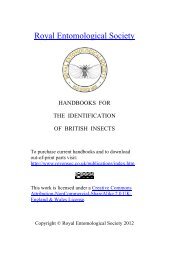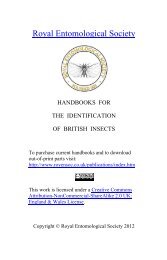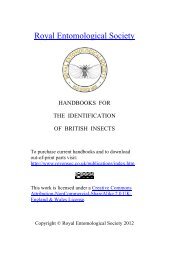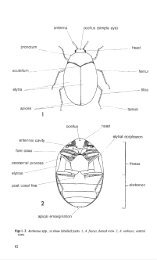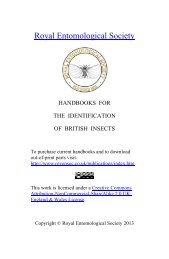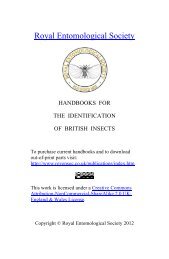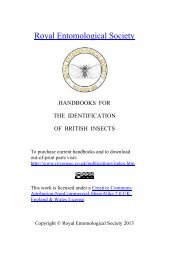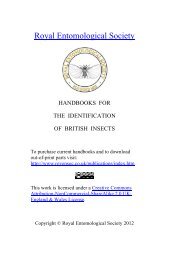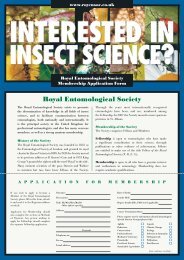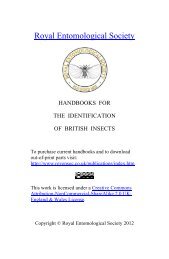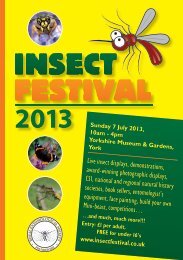Vol 10 Part 14. An introduction to the immature stages of British Flies ...
Vol 10 Part 14. An introduction to the immature stages of British Flies ...
Vol 10 Part 14. An introduction to the immature stages of British Flies ...
Create successful ePaper yourself
Turn your PDF publications into a flip-book with our unique Google optimized e-Paper software.
(Memoires); Museu de Zoologia, Universidad de Sao Paulo (Papeis Dep. Zoo/. S.<br />
Paulo); Parasitica, Gembloux (Seeger & Maldague); Royal En<strong>to</strong>mological Society <strong>of</strong><br />
London (Proceedings, Transactions, Handbk !dent. Br. Insects, <strong>An</strong>tenna, J . ent. (A) &<br />
(B), Syst. Ent.); Royal Society, London (Phi/. Trans. Hin<strong>to</strong>n, Mad war); Schweizerbart<br />
Verlag, Stuttgart (Die Fliegen der Palaearktischen Region, Engel, Hennig); Societe<br />
En<strong>to</strong>mologique Suisse, Lausanne (Mitt. Schweiz ent. Ges); Societe Zoologique de<br />
France, Paris (Bulletin); Staatlichen Museum fiir Naturkunde, Stuttgart (Stuttg. Beitr.<br />
Naturk.); Taylor & Francis Ltd., London (<strong>An</strong>n. Mag. nat. Hist., Keilin); Zoological<br />
Institute <strong>of</strong> <strong>the</strong> Polish Academy <strong>of</strong> Sciences, Warsaw; Institute <strong>of</strong> Evolutionary Morphology<br />
& Ecology <strong>of</strong> <strong>An</strong>imals, <strong>of</strong> <strong>the</strong> USSR Academy <strong>of</strong> Sciences and "Nauka"<br />
Publishers, Moscow; Zoological Society <strong>of</strong> London (Proceedings, Transactions, J.<br />
Zoo/., Frew); Zoologicheskii Zhurnal, Moscow.<br />
I thank <strong>the</strong> following for very kindly providing original pho<strong>to</strong>graphs: A. E. MeR.<br />
Pearce (figs 89-91), Dr K. M. Harris and J. Brown (figs 123-5) and B. van Aartsen and<br />
G. Helmers Jr. (fig. 270).<br />
For providing specimens, literature or information on Diptera larvae over <strong>the</strong> years I<br />
am indebted <strong>to</strong>: Dr Peter Bailey, L. Christie, Pr<strong>of</strong>. A. F . G . Dixon, Dr Y. Z.<br />
Erzinc;Iioglu, N. French, D. Green, Dr K. M . Harris, Pr<strong>of</strong>. B. Herting, <strong>the</strong> late Pr<strong>of</strong>. W.<br />
Hennig, <strong>the</strong> late Pr<strong>of</strong>. H. E. Hin<strong>to</strong>n, F.R.S., <strong>the</strong> late Dr B. M. Hobby, Dr A. G. Irwin,<br />
Dr D . P. Knight, Dr B. R. Laurence, Dr Jane Marshall, P. M. Miles, Dr A. J. Pontin,<br />
Dr M. W. Shaw, Dr M. C. D. Speight, C. Vardy, <strong>the</strong> late Pr<strong>of</strong>. G . C. Varley, P. Wi<strong>the</strong>rs,<br />
London and Whipsnade Zoos (Zoological Society <strong>of</strong> London), and all those veterinarians,<br />
pathologists, forensic scientists, environmental health and Ministry <strong>of</strong><br />
Agriculture (ADAS) <strong>of</strong>ficers <strong>to</strong>o numerous <strong>to</strong> mention here individually, though<br />
some are credited in <strong>the</strong> text for particular records.<br />
Adrian Pont very kindly helped me with translating <strong>the</strong> subtleties <strong>of</strong> <strong>the</strong> German and<br />
Russian languages, thus avoiding many misinterpretations from <strong>the</strong> literature.<br />
Finally I thank my wife for her careful and critical preparation <strong>of</strong> <strong>the</strong> typescript, her<br />
painstaking pro<strong>of</strong>-reading and compilation <strong>of</strong> <strong>the</strong> index, and her enthusiastic support<br />
throughout my en<strong>to</strong>mological activities.<br />
Life-his<strong>to</strong>ries and ecology<br />
<strong>Flies</strong> are highly adaptive insects and <strong>the</strong>ir larvae develop successfully in a very wide<br />
range <strong>of</strong> media, e.g. soil, rotting wood, plant and animal tissues (including man, alive or<br />
dead), fungi, dung and sewage, water (mostly fresh, sometimes brackish, occasionally<br />
marine), hot springs and geysers (some Ephydridae, Stratiomyidae) and even in petroleum<br />
pools (Halaeomyia, Ephydridae). Diptera exploit most <strong>of</strong> <strong>the</strong> available ecological<br />
niches in most <strong>of</strong> <strong>the</strong> biological roles, e.g. saprophages (many), commensals (some<br />
Sca<strong>to</strong>psidae, Chironomidae and Phoridae), preda<strong>to</strong>rs (many), parasites (many),<br />
symbionts (some Chironomidae and algae) and scavengers.<br />
Most <strong>of</strong> <strong>the</strong> protein feeding is done in <strong>the</strong> larval stage and <strong>the</strong> adults mostly need<br />
water <strong>to</strong> replace that lost during activity, especially flight, and sugars, from nectar or<br />
honeydew, <strong>to</strong> provide <strong>the</strong>ir energy. Some adults also take protein, e.g. preda<strong>to</strong>rs, blood<br />
feeders, pollen feeders.<br />
As a rule, aquatic larvae are carnivorous or live on algae. Apart from preda<strong>to</strong>rs,<br />
<strong>the</strong> precise nature <strong>of</strong> <strong>the</strong> food taken by terrestrial larvae is <strong>of</strong>ten inadequately<br />
known. Thus <strong>the</strong> larva <strong>of</strong> <strong>the</strong> bluebottle (Calliphora) is classed as a carrion feeder but in<br />
fact bacteria on <strong>the</strong> carrion are probably <strong>the</strong> main food source (Roberts, 1971 a).<br />
Similarly bacteria are probably <strong>the</strong> main source <strong>of</strong> food and vitamins for housefly<br />
larvae (Levinson, 1960). Baumberger( 1919) found that many supposedly saprophagous<br />
fly larvae are actually myce<strong>to</strong>phagous. Clearly <strong>the</strong>re is plenty <strong>of</strong> scope for careful<br />
research here.<br />
6




